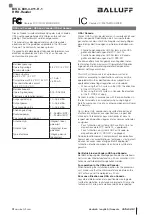
13
Installation Manual
Due to our policy of continuous product innovation, some specifications may change without notification.
©LG Electronics U.S.A., Inc., Englewood Cliffs, NJ. All rights reserved. “LG” is a registered trademark of LG Corp.
INSTALLATION
Types of Input Wiring
Each of the 5 UI inputs supports any of the following:
• Type-3 10K ohm Thermistor (see NOTE, below)
• Resistive 0-100K ohms
• 0–10 Vdc
• 4–20 mA
• Binary Input
Thermistor UI Wiring
The inputs support 10K Thermistor temperature sensors. Input accuracy is in the range of ±1% of span. By default, conversion
is for a standard Type 3 thermistor sensor with a sensor range of -10° to 135°F (-23.3° to 57.2°C). Using a conversion type of
“Tabular Thermistor,” you can specify a different thermistor response curve by importing a thermistor curve .xml file. The Niagara
kitIo module contains an xml folder with thermistor curves for various thermistor temperature sensors. You can also edit and export
(for reuse) customized thermistor curve xml files. See the
NRIO Driver Guide
for details.
0 V U 5 U 4 0 V U 3 U 2 0 V U 1
1
2
4
3
1. Use shielded, twisted cable (1) 61m (200 ft) max.
2. Cut and tape back shield wire (2) thermistor (3) end.
3. Connect the other end of shield wire to ground (4) (for example, use a stud in an enclosure).
Resistive 0-100K ohms UI Wiring
The inputs can read a resistive signal within a range from 0 to 100,000 ohms. Wiring is the same as shown for a Thermistor tem-
perature sensor, above.
NOTE:
UI inputs provide optimum resistive-to-temperature resolution in the 10K ohm range.
For a sensor with a range far from 10K ohms (such as a 100-ohm or 1000-ohm sensor), resolution is so poor as to be unusable! To suc-
cessfully use such a sensor, install a transmitter that produces a Vdc or mA signal, and then wire the transmitter to the UI according to the
0–10 Vdc or 4–20 mA instructions.
0-10 Vdc UI Wiring
The inputs support self-powered 0–10 Vdc sensors. Input impedance is greater than 5K ohms.
0–10 volt accuracy is ±2% of span, without user calibration.






































